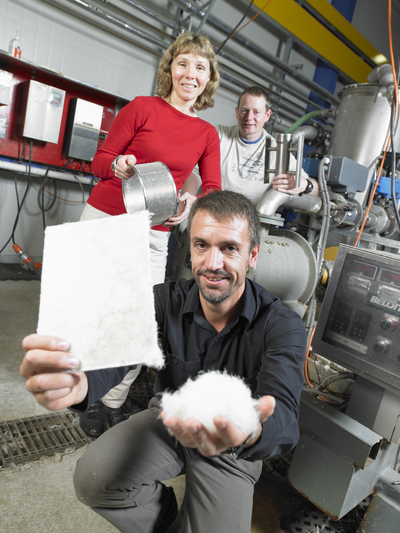Feathers one day, fibre the next
Every year, New Zealand produces about 50,000 tonnes of chicken feathers. In the past the only options for these feathers were to process them into low-grade animal feed, incinerate them or store them in landfills. But the feathers are now being sought as extra support for biodegradable plastics. An example of this concept was announced in March 2011, when American scientists including Dr Yiqi Yang demonstrated that they could make chicken-feather-based thermoplastics which remained stable in water. A little over a year later, at the University of Waikato, a similar incident is occurring.
Dr Johan Verbeek, along with his colleagues Dr Kim Pickering and Dr Mark Lay, are taking chicken feathers and turning them into a biodegradable fibre which, when added to plastic, could be strong enough to use in the marine industry. Adding the feathers to a plastic compound produces a stronger, more resilient product; Dr Verbeek aims to use this to make “something like a glass fibre that can be used on boat hulls”. Other applications could also include ceiling panels or packaging - basically anything requiring rigidity or strength.

Dr Verbeek and his team are no strangers to animal products, having previously done work turning blood meal into a thermoplastic for the agricultural industry. The university’s commercialisation company, WaikatoLink, is currently working with Australian and New Zealand companies to get a product to market, while co-product company Wallace Corporation is a strategic partner in the development of blood meal-based plastics.
Dr Verbeek said, “Wallace Corporation suggested that we work on chicken feathers as well since they process most of NZ’s feathers into feather meal, which is used as animal feed. Recovering fibre from the feathers has been identified as a potential product because of that.”
Dr Yang, an authority on biomaterials and biofibres in the Institute of Agriculture & Natural Resources at the University of Nebraska-Lincoln, has explained why chicken feathers are a suitable material. They are inexpensive, abundant and made mainly of keratin - a tough protein also found in hair, hoofs, horns and wool that can lend strength and durability to plastics. He added that the mechanical properties of feather films outperform other bio-based products, such as modified starch or plant proteins.
For Dr Verbeek, an added advantage was that “chicken feathers are lighter than glass or carbon and save on weight and therefore energy”.
This is important to consider, as the process of converting feathers to fibre is quite an intensive one.
“Raw feathers have to be cleaned and then the fine fibres need to be stripped from the rachis, the hard bit in the middle,” Dr Verbeek said. “It’s not a quick process and at this stage is rather energy intensive - we’ve not looked into improving the efficiency yet as it is too early for us.”
But once the process is perfected, the energy payoff will be present in a variety of ways. Dr Verbeek said the ultimate aim is producing a biodegradable alternative to foam packaging.
“In a compost or landfill it would be gone in six months whereas polystyrene takes centuries to decompose. Our product won’t compete with polystyrene because there will never be enough raw material but there is enough to make a viable business.”
Though Dr Verbeek admitted it will “be a while” before we can expect chicken-feather-plastics on the market, it is an exciting prospect to know that previously disposable animal products are being used to improve both the performance and the environmental impact of plastic.
“The second holy grail for us is plastic bags,” teased Dr Verbeek. “That’s a major thrust of our research.”
Scientists find new uses for veggie waste
Researchers have detailed how food waste can contain sustainable solutions for farming and new...
Repurposing ocean plastics into window furnishings
Luxaflex is turning plastic waste collected from beaches and waterways into high-quality window...
CDE transforms hydrovac waste into valuable commodity
An NZ plant using CDE technology is recovering around 48,000 tonnes of reusable material annually...









